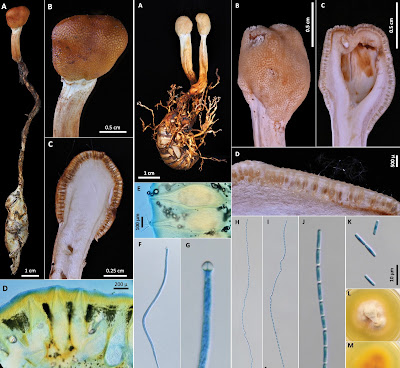 |
Odorrana confusa
Song, Zhang, Qi, Lyu, Zeng, Zhu, Huang, Luan, Shu, Gong, Liu & Wang, 2023
|
Abstract
Taxonomic studies of the Odorrana versabilis group have been consistently disorganized, and they have often been incorrectly associated with an abandoned subgenus or genus Bamburana in existing literature. In this study, we conducted an integrative taxonomic analysis using molecular phylogenetic analysis of two mitochondrial gene fragments (16S rRNA and CO1) and morphological examination of 41 specimens collected during herpetological surveys in southern China. Our results confirmed the monophyly of O. versabilis group which exhibited distinct morphological traits. We also identified a cryptic lineage sister with O. exiliversabilis. Additionally, our study revealed that O . trankieni was nested within O. nasuta. Consequently, we redefined the morphological characteristics of the O. versabilis group, described a new species in this group, O. confusa sp. nov., and proposed that O. trankieni be considered a junior synonym of O. nasuta. One of the most significant findings of this study was the observation of distinct morphological changes in adult males across all species within the O . versabilis group between the non-breeding and breeding seasons. This study contributes to research on various aspects of Asian amphibian fauna, including taxonomy, ecology, evolution, and physiology.
Keywords: morphological changes, Odorrana confusa sp. nov., Odorrana nasuta, Odorrana trankieni, species group, taxonomic revision
 |
Holotype of Odorrana confusa sp. nov. in life
on (A) dorsolateral view, (B) dorsal view, (C) ventral view, (D) head, (E) hand, (F) foot, (G) nuptial pad and (H) habitat.
Photos by Jian WANG and Shuo QI. |
Odorrana confusa Song, Zhang, Qi, Lyu, Zeng and Wang sp. nov.
Rana versabilis — Ding et al., 1980; Zou, 1983.
Odorrana exiliversabilis — Fei et al., 2001.
Odorrana (Bamburana) exiliversabilis — Fei et al., 2005, 2009.
Odorrana versabilis — Rao et al., 2013; Li et al., 2018; Gong and Wu, 2020.
Bamburana versabilis — Yang et al., 2018.
Diagnosis: Odorrana confusa sp. nov. is distinguishable from its congeners based on the following combination of characteristics: (1) well-developed dorsolateral folds; (2) prominent morphological changes in adult males between the non-breeding and breeding seasons, during the breeding seasons, elongation of the snout beyond the lower jaw, lateral swelling of shoulder regions, dorsolateral fold swelling, and increased robustness of the forelimbs; (3) shagreened skin with occasional conical or sharp tubercles behind the sacrum, around dorsolateral folds, or on the rictal, temporal, and loreal regions, or the upper and lower lips; (4) tympanum distinct and round, not concave or just slightly concave, not forming an external auditory canal in both sexes; (5) tips of fingers expanding into disks; (6) edge of web on toe Ⅳ reaching the disk; (7) dorsal skin behind sacral vertebrae slightly smooth, with either no or few tubercles in both sexes; (8) flanks with messy stains and numerous tubercles; (9) rictal glands and lower jaws of adult male with numerous prominent white conical spinules, especially during breeding seasons; and (10) body size large, with the SVL of adult males and females averaging 68.5 mm (64.4‒72.5 mm) and 70.9 mm (67.0‒73.9 mm), respectively.
Etymology: The specific name, confusa, is derived from the feminine form of the Latin adjective “confusus,” meaning “confused” or “mixed.” This refers to the chronical taxonomic confusion of this newly discovered species with the Odorrana exiliversabilis .
Suggested common name: “Chebaling bamboo-leaf frog” in English and “车八岭竹叶蛙 (chē bā lǐng zhú yè wā)” in Chinese.
Distribution: The phylogenetic and morphological findings suggested that Odorrana confusa sp. nov. is endemic to China, specifically in Chebaling, Mt Nankun and Mt Longtou in Guangdong, Mt Jinpen in Jiangxi, and Mt Daiyun in Fujian (Figure S1). Further research is required to better understand the precise distribution of this species.
 |
Morphological comparisons of adult males of
(A) Odorrana confusa sp. nov., (B) O. exiliversabilis, (C) O. nasuta and (D) O. versabilis between (1) the non-breeding season and (2) the breeding season in life.
Photos by Yingyong WANG, Jian WANG, Zhaochi ZENG, Zhitong LYU, and Yongheng ZHU. |
 |
Six species of Odorrana versabilis group in life.
(A) Odorrana confusa sp. nov., (B) O. exiliversabilis, (C) O . nasuta, (D) O. tormota, SYS a002708, (E) O. versabilis and (F) O . yentuensis.
Photos by Yingyong WANG, Shuo QI, Zhitong LYU, and Yongheng ZHU. |
Odorrana versabilis group
Odorrana nasuta Li, Ye and Fei, 2001
Revision of Odorrana exiliversabilis
Odorrana exiliversabilis Li, Ye and Fei, 2001
Etymology: The specific name, exiliversabilis, is derived from the combination of “exili-” and “versabilis,” indicating that this species is smaller in body size than Odorrana versabilis.
Suggested common name: “Little Bamboo-leaf Frog” in English and “小竹叶蛙 (xiǎo zhú yè wā)” in Chinese.
Hanming SONG, Siyu ZHANG, Shuo QI, Zhitong LYU, Zhaochi ZENG, Yongheng ZHU, Minghai HUANG, Fuchen LUAN, Zufei SHU, Yuening GONG, Zhifa LIU and Yingyong WANG. 2023. Redefinition of the
Odorrana versabilis Group, with A New Species from China (Anura, Ranidae,
Odorrana).
Asian Herpetological Research. DOI:
10.3724/ahr.2095-0357.2023.0019












































